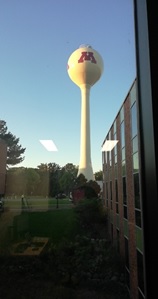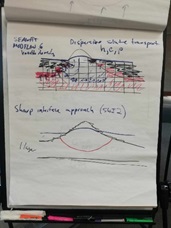From the Frontlines of Research and Studies [USA]: Chris Leong (Research Institute for Humanity and Nature)

The National Institutes for the Humanities (NIHU) sends young scholars, who are participants in Institute-based projects and co-creation initiatives, to international seminars and research institutions abroad, including universities. This program aims to promote NIHU’s projects and support young scholars in their academic studies, presentations at international seminars, and other overseas research opportunities.
In this issue, we feature a report from Chris Leong of Research Institute for Humanity and Nature, who was dispatched to USA
Groundwater Modelling and Saltwater Intrusion Research Visit to USGS Minnesota
As part of my work as a researcher under the LINKAGE Project at the Research Institute for Humanity and Nature (RIHN), I conducted a research visit from September to November, 2024, to the U.S. Geological Survey (USGS) Minnesota Water Science Center (in Figure 1) to learn first-hand about the Modflow6 software and its Flopy package (python language) developed by the USGS water specialists. Modflow6 was selected by the LINKAGE Project as a key tool for capacity building in groundwater dynamics and resource management because it is freely accessible and well-suited for application in our study sites, many of which lack the financial resources to invest in costly proprietary modelling software. This accessibility ensures that local partners can adopt and sustain the use of advanced modelling techniques for long-term groundwater management and planning. At the USGS Centre I collaborated with groundwater specialists to learn and advance numerical modelling techniques for saltwater intrusion and freshwater lens dynamics in small island aquifers.

The LINKAGE Project focuses on understanding how land–ocean interactions—particularly submarine groundwater discharge (SGD) and land-based nutrient fluxes—influence coral reef health and community resilience in Pacific and Southeast Asian Island nations. My specific contribution lies in developing and refining physically based models to simulate how human activities affect groundwater systems and its dynamics that impact coral reef ecosystems, especially in low-lying islands.
During the two-month visit, I received intensive training in the application of MODFLOW 6 and the FloPy Python library, both of which are state-of-the-art tools for modelling complex groundwater flow and saltwater intrusion (in Figure 2). Working closely with USGS modelers, I learned advanced methods for:
• Configuring transient, tidally influenced coastal boundary conditions
• Simulating density-dependent flow in freshwater–saltwater systems
• Generating physically consistent initial conditions using bathymetry and tide-driven heads
• Conducting parameter calibration and sensitivity analysis under uncertainty

This hands-on collaboration provided critical technical insights that are directly applicable to LINKAGE modelling case studies in Kuroshima (Japan), Wangi-Wangi (Indonesia), and Rakiraki (Fiji). These sites are characterized by fragile freshwater lenses, limited groundwater availability, and active coral reef ecosystems—conditions that require careful modelling to support sustainable resource management and nature-based adaptation.
Beyond technical training, the visit allowed for rich exchanges and establish a network with USGS scientists on topics such as groundwater–surface water interactions, model validation with observed data, and the integration of hydrological modelling with community-based monitoring. These conversations reinforced the importance of collaborative science across institutions and disciplines.
I also had the opportunity to present LINKAGE’s transdisciplinary framework to USGS colleagues, illustrating how hydrological modelling, coral reef science, and community co-design can be combined to generate context-sensitive solutions. Participating in informal seminars and discussions further connected USGS's applied research with global challenges in water security and ecosystem resilience of developing small island states.
This research stays deepened my technical capabilities and broadened my international research network. The insights and tools acquired during this visit are now being incorporated into LINKAGE’s ongoing modelling, capacity-building workshops, and policy engagements across the Asia-Pacific region. I am deeply grateful to the USGS Minnesota team for their generous mentorship and hospitality, and to RIHN and the LINKAGE Project collaborators for supporting this enriching exchange.
In particular, I extend my sincere thanks to NIHU for approving my application under the Visiting Researcher Program. This opportunity has greatly enhanced the scientific rigor of my work and laid the groundwork for a fpeer-reviewed publication based on the methods and insights developed during this stay. It will also contribute directly to the academic outputs of the LINKAGE Project, advancing its mission to co-produce science that supports resilient coastal and island communities.
Chris Leong Ph.D. (Science and Engineering)
Researcher, LINKAGE Project, Research Institute for Humanity and Nature (RIHN)
Chris Leong is a hydrologist specializing in numerical modeling of groundwater systems, with a particular focus on saltwater intrusion and freshwater lens dynamics in small island environments. His research integrates MODFLOW 6 and FloPy-based modeling with field-based data and community collaboration to support sustainable water resource management across Pacific and Southeast Asian islands.
Currently, he leads the Modflow6 modelling component of the LINKAGE Project, which investigates land–ocean interactions and their impacts on coral reef health and island community resilience. His work aims to bridge science and society through transdisciplinary approaches that inform policy and build local capacity for small developing island states.
